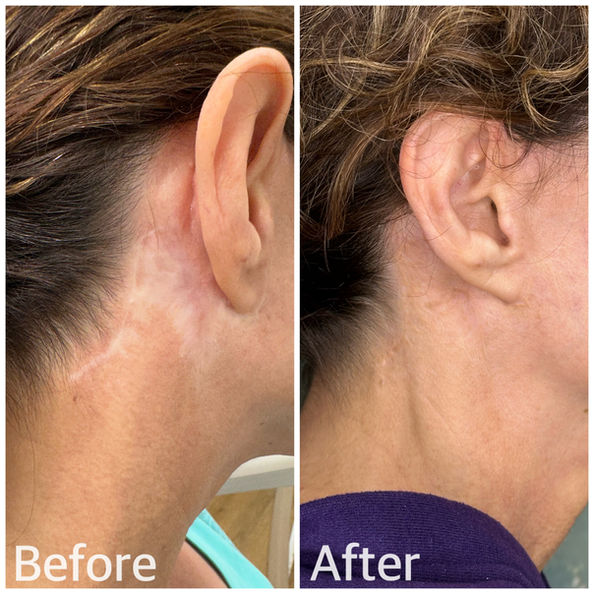Scar Camouflage
Using the Art of Tattooing to enhance and correct

The best kind of scars to camouflage are hypopigmented scars. This means the skin has lost pigment due to trauma. Melanocytes in the skin are damaged and no longer produce color, leaving your scar white.
Just like matching foundation, we will swatch your skin with different pigments to find the perfect colors for you. We create a custom blend for your color match and tailor the rest of the procedure to best suit your specific scar. The process of tattooing causes thin needles to go in and out of the skin. This is an added benefit because it breaks up scar tissue and relaxes it. It also encourages new collagen to replace the damaged tissue, thereby smoothing the look of the scar.
After the procedure, pictures will be taken to document the transformation and aftercare ointment is provided along with after-care instructions.
A follow-up procedure is recommended 6-8 weeks after the initial appointment. Depending on the scar, the process may need to be repeated to get the best results. Some thicker scars require more sessions to achieve optimal camouflage.
What to Expect
Avoid While Healing:
-
Excessive moisture, such as steam or saunas
-
Swimming or excessive sweating
-
Pets near treatment area
-
Gardening
-
Excessive sun exposure
-
Touching with dirty hands
-
Baths or Jacuzzis
-
Tight fitting clothing that doesn't allow the treatment area to breathe.
Immediately after the procedure, you may experience some swelling and redness which should subside within 24-48 hours. If needed, you can use a cold compress on the area to help the swelling go down.
After a few days, the area may begin to flake off a layer of pigment and you may experience some dryness and itchiness in this stage. Avoid peeling, picking, and scratching the area, it is all a part of the process!
Once the pigment begins to flake off, there may be a much lighter pigment revealed underneath. This lighter pigment will continue to develop over the next few weeks and darken a bit with time. You may also experience post inflammatory hyperpigmentation during healing. This is when the treated area appears darker than the surrounding skin. This is totally normal with certain skin types and should fade away within a few weeks. You must wait 5-6 weeks to asses your fully healed results.
If, after 6 weeks, you would like to add more color, please contact us to schedule a followup appointment. Scar Camouflage followup fees are typically $200-$500 depending on the area.
It’s important to remember that everyone’s skin is unique and will heal and retain pigment differently. Medical tattoo can often times take more than one session to achieve desired results. For all of our procedures, we recommend a follow-up appointment at six weeks to ensure you’re happy with how everything has healed and to assess whether any additional coverage or adjustments are needed. Because our goal is to achieve soft, natural-looking results, we intentionally work on the lighter side during the initial session—pigment can always be built up over time, while removal is much more difficult. Some skin types are more resistant, while others retain pigment very easily, which is why this approach allows us to customize your final result beautifully.
We recommend booking your follow-up appointment right away to ensure that you get a convenient time slot. It’s best to schedule a follow-up for 6 weeks after your procedure to check on the results.
Pre Procedure Care
-
Avoid alcohol and blood thinners like Ibuprofen, Aspirin, Advil, or fish oils a minimum of 48 hours before the procedure for best results.
-
Avoid waxing, facials, and beauty treatments the week before your procedure to ensure your skin is not peeling or reacting to the treatments.
-
Discontinue the use of Retinol/Retin A and products containing Tretinoin a minimum of 2 weeks prior to your appointment.
-
Do not have a sunburn on your skin at time of appointment.
-
No accutane and must be off of accutane for a minimum of one year before having a permanent makeup procedure done
-
Avoid caffeine the morning of your appointment.
-
Do not be under the influence at time of procedure.
-
Must be over 18 years of age and prepared to show Proof of age.
-
Must not be pregnant
Post Procedure Care
-
Avoid tight clothing, saunas, swimming, steamy showers, sweating, beauty treatments, pets near the area, touching with dirty hands, and direct sunlight for 7-10 days after the procedure.
-
Avoid using products like scented lotions, serums, and sunscreens directly on the treated area for 7-10 days. While healing, avoid using anything other than a gentle soap and aftercare ointment on the area.
-
Also avoid facials (if face or neck was treated), chemicals like Retinol, AHA & BHA, and exfoliants for 30 days after the procedure.
-
Wash the area morning and night for the next 7 days. Use an unscented, gentle antimicrobial soap/cleanser, create a lather in your hands and gently massage the treated area for 30 seconds, rinse with lukewarm water and pat dry with a paper towel. Wait about 10 minutes for the area to dry completely, then apply the aftercare ointment using a qtip.
-
Make sure the amount of ointment is minimal. You only need a thin layer of aftercare to help your skin heal, applying aftercare in excess will inhibit the healing process. For example: facelift scars only need a rice grain amount of ointment. This amount will be sufficient to cover both scars on each side.
-
If given Sandierm: Keep the Sandierm on for 5-7 days after treatment unless it begins to lift early or cause irritation. When ready to remove, do so in a warm shower and gently wash afterwards. **Do not worry about performing the daily cleansing/ointment aftercare if you have been given Saniderm.**



